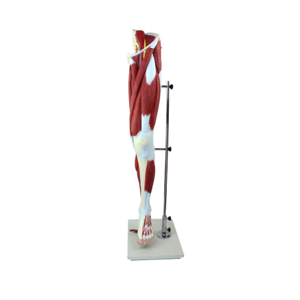

Article tag: Lower limb muscle anatomy model| muscle anatomy model|
As an effective assistant in medical education and rehabilitation training, the lower limb muscle anatomy model accompanies learners from beginners to experts in every step of growth. In its unique way, it guides us to gradually underst...
As an effective assistant in medical education and rehabilitation training, the lower limb muscle anatomy model accompanies learners from beginners to experts in every step of growth. In its unique way, it guides us to gradually understand the complex structure and function of lower limb muscles, so as to be able to use it in the medical field and rehabilitation practice.
In the initial stage of knowledge, with its intuitive, vivid form, for us to uncover the mystery of the lower limb muscles. Beginners can easily identify the main muscle groups such as the quadriceps of the thigh and the triceps of the calf by touching and observing the model, and initially establish the overall cognition of the muscle structure of the lower limb. This process not only stimulates learners' interest, but also lays a solid foundation for further study.

With the deepening of learning, it began to play a more important role. By dissecting each muscle in the model in detail, learners can learn where the muscle starts, stops, functions, and how it relates to other structures. This refined learning makes our understanding of lower limb muscles no longer stay on the surface, but go deep into its internal structure and functional mechanism. At the same time, the model can also be combined with multimedia teaching resources, such as videos, animations, etc., to further deepen our understanding of muscle dynamic changes and movement principles.
In the advanced stage, it has become an important tool for our clinical practice and scientific research exploration. By simulating muscle changes in actual operation, the model can help us better understand the changes of lower limb muscles in disease states, so as to develop more accurate rehabilitation plans and treatment programs. In addition, the model can also be used for muscle morphological measurement and functional evaluation in scientific research experiments, providing strong support for our scientific research.
Ultimately, when we become experts in the field of medicine or leaders in the field of rehabilitation, the anatomical model of the lower limb muscle remains our indispensable partner. It has witnessed our growth and progress, but also reminds us to always maintain the reverence and pursuit of medical knowledge.